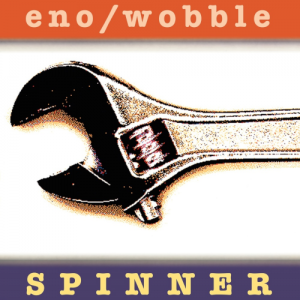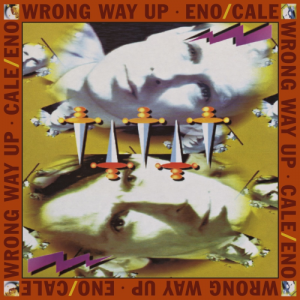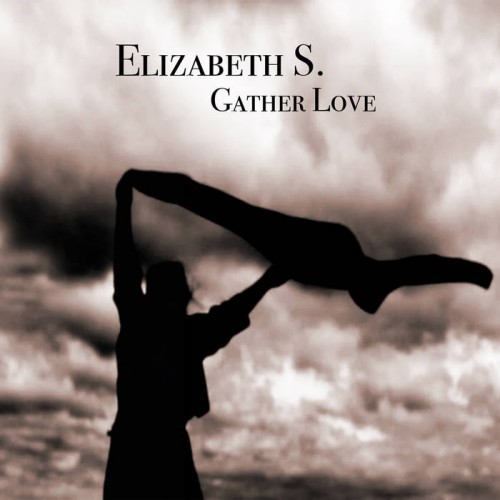 Spinner is an oddity, even in Brian Eno’s vast back catalogue; the music was originally conceived as the soundtrack to Derek Jarman’s film Glitterbug, a posthumously released compilation of old super 8 film that had been gathered together as the director was dying of AIDS.
Spinner is an oddity, even in Brian Eno’s vast back catalogue; the music was originally conceived as the soundtrack to Derek Jarman’s film Glitterbug, a posthumously released compilation of old super 8 film that had been gathered together as the director was dying of AIDS.
“Where We Lived” is a meditative Eno etude, full of lush synthesizer sounds that evoke a quiet mood and hang in the atmosphere heavily like a storm on a humid day. “Like Organza” is more awkward-sounding, its DADA-esque chords falling over each other, with Wobble’s bass fairly subdued beneath Eno’s clanging synth work and the track feels like a heartbeat pulse that beats against the ambient pads layering the sound. “Steam” has Justin Adams on guitar and Mark Ferda providing atmospheres. The opening reminded me slightly of early Dead Can Dance with its orchestral-sounding synths; then all of sudden it judders into a big rhythm that is quite unexpected at that point. and the guitar almost hops psychedelically over the top of a sedate funky beat.
“Garden Recall” is a typical Eno piece of this period; it conjures up images of Japanese Zen gardens over oblique synth sounds and quiet mood. This is almost a style that Eno invented, an arty ambience that could just as well be the music for an exhibition as well as in this case a film. “Marine Radio” has a funky bass beginning over Richard Bailey’s rolling rhythm. The sound of the synth reminds me of that used on Japan’s “Life Without Buildings” from 1981. The track brings in awkward synth stabs while the bass slaps occasionally, startling the listener out of any relaxed mode they may have found themselves in. The keyboards have an almost world music sound at points and carry the melody forward, and for comparison I can only think of some of Ryuchi Sakamoto’s work. The last track on side one is “Unusual Balance”, a piece that features Sussan Deyhim on vocals. Here, we get a more aggressive tone of bass and keyboards working together over a pounding drum section, and this could almost be dance music if it wasn’t for its ambient interludes. The vocals are a wordless scream and sit hauntingly within the piece. The guitar chops around and everything swirls in a flanged phasing of sound that travels between speakers. “Space Diary” is a short piece that reminded me more of Eno’s work with Harold Budd; its chords are light and breezy like leaves caught in an autumn wind. “Spinner” has Can’s Jaki Liebezeit playing a drums while Wobble hits the high notes on the bass, giving the track a sense of urgency. Eno’s keyboards continue the feel of the previous track and seem to pull back the sense of momentum that the rhythm section is pushing.“Transmitter And Trumpet” again has Liebezeit on drums, thought it begins with a wash of disturbing atmospherics and the percussion seems to have been put through various effects to make them sound almost electronic at points. A slight gamelan rhythm surfaces, then disappears into the mush of synthesizer sounds, and the track seems to rise and fall like an ocean of sound or a radio station not tuned in properly. It’s an unsettling effect that makes for an odd listening experience, as if hearing two different pieces on two slightly detuned radios as the sound keeps hitting you and then almost running away.
“Left Where It Fell” seems at first to be an extension of the earlier track, but evokes something more akin to Eno’s Apollo work at first, until a rhythm hits in and deep piano tones resonate over steady bass notes. Here we get some middle eastern-sounding keyboard notes that play over a steady drum pattern, and again this sound hints at Dead Can Dance to me, but is done in a less dramatic way, even though it points in a similar direction at times. It’s a fine ending to the original album and one that hangs in the room after the record has stopped spinning. The two extra tracks are download-only; one by Eno called “Stravinsky” from the Glitterbug soundtrack, and one by Wobble called “Lockdown”. Spinner is an odd album as it’s a soundtrack that isn’t and a three-quarters collaboration. I certainly didn’t find Wobble’s bass lines as intrusive as Eno mentioned in his diary, and the funk aspects are kept to a minimum in the overall sound palette. This glorious-sounding 180 gramme vinyl comes with sleeve notes from both Eno and Wobble discussing how the work came about. For collectors of both artists, its nice to have such a well put-together reissue of this album. Just let Eno and Wobble take you on a strange journey for a little while — you won’t regret it.
 Brian Eno and John Cale had first worked together on the June 1st 1974 project with other ex-Velvet Underground member Nico and ex-Soft Machine star Kevin Ayers. The two had remained in each other’s orbit ever since, with Eno producing some of Cale’s work. So it was fortuitous that after producing Cale’s latest album the two decided to work together in 1990. The sessions started out idyllic as the album was recorded in Woodbridge, away from the hustle and bustle of London.
Brian Eno and John Cale had first worked together on the June 1st 1974 project with other ex-Velvet Underground member Nico and ex-Soft Machine star Kevin Ayers. The two had remained in each other’s orbit ever since, with Eno producing some of Cale’s work. So it was fortuitous that after producing Cale’s latest album the two decided to work together in 1990. The sessions started out idyllic as the album was recorded in Woodbridge, away from the hustle and bustle of London.
“Lay My Love” has a funky rhythm carried along by Neil Catchpole‘s violins, Eno’s DX7 pads and Cale’s pulse piano. Stylistically, it reminds me slightly of XTC’s late eighties output, and Eno’s vocals certainly deliver a strong hook and it is probably the most hummable thing he had done in ten years. It’s also a joyous piece of music that seems at odds with the fractious way it was recorded . “One Word” has a slightly more edgy feel, with its backing reminding me of My Life In The Bush Of Ghosts; that is, until the chorus hits in and suddenly you are in pop heaven with the kind of languid vocals Eno used to deliver on Before And After Science. A point of note here is that his and Cale’s tones merge together quite beautifully and have a wonderful harmonic texture, with Ronald Jones‘s drum work keeping the pace moving while Robert Ahwai’s guitar is suitably both funky and arty.
Cale takes over singing duties for “In The Backroom”, a track that has a cocktail lounge on Mars feel about it. Eno makes a solid rhythm bed which tucks in the corners nicely, while Cale’s piano and horn burst in at the right points. The guitars here sound quite wonderful and expansive as they lose the jitter of the first couple of tracks. “Empty Frame” has a big gated drum sound over which horn-sounding synths stab in at various points. The song has the laid back feel of a lazy summer afternoon, and Eno delivers an impassioned vocal at the higher end of his register which mixes fifties doo-wop with a bit of soul that makes for an intoxicating blend. “Cordoba” is probably the most experimental track so far, a subdued piece that is quietly intoxicating with haunted chords and a quiet vocal from Cale that sounds melancholic as it tells the story of events, his viola adding an extra element of sadness to proceedings. “Spinning Away” is back to big rhythms, this one sounding like a jaunty summertime song and really could have been a hit single. Eno’s vocals are probably the most catchy of his entire career, and it’s a great (dare I say it) pop song. The melody is uplifting with a slight hint of sadness in there, but it’s just so damn tuneful that you can’t help letting it overtake you that your feet automatically start tapping along to it. The whole thing sounds lush and rather wonderful. “Footsteps” has a kind of ethnic sound to its melody, but also reminded me of the sort of songs that The Stranglers were having hits with a couple of years earlier. Cale’s vocal is stronger in the mix here than in some of the previous songs, and that is always a good thing.“Been There, Done That” has an element of an ABC hit single about it. Cale’s lead vocals are strong and the melody swims along nicely. It has a choir of backing vocals during the chorus that take the song to almost chant-along territory. If it had ever been played live (which it wasn’t), you can almost imagine an audience singing along to it. “Crime In The Desert” is a good ole rock and roll number with some Jerry Lee Lewis-sounding keyboards from Cale that makes the song have a honky-tonk four-bar feel to it. Cale and Eno’s vocals merge effortlessly again and give the track a slightly country and western feel, a great fun track where its good to see the two artists throw in lots of ideas for different styles.
“The River” doesn’t feature Cale at all, but instead Brian’s brother Roger Eno. It feels like a song that was left off Before And After Science, or a song that could have been written for The Cowboy Junkies, its meandering pace reminding me of the river section in the film Night Of The Hunter, with its animals silhouetted against the painted night sky. It’s a beautiful Eno track full of longing and sadness that has a sense of yearning for something else, even though it was written for his newly born daughter at the time. Again, All Saints‘ 180 gramme vinyl release sounds fantastic and the cover is reproduced to the highest quality. Two bonus tracks, “Grandfather’s House” and “Palanquin”, are added as download-only extras, and the inner sleeve features a 1990 interview with Eno discussing the making of the album. In a way, it’s a shame that this was only a one-off project as it would have been interesting to hear how the two would have developed their sound on subsequent releases. Neither of them would be quite so obviously poppy again on their own solo records, although Eno hints at it on his Another Day On Earth album. Wrong Way Up is an oddity of a record in some respects, but it’s most definitely a beautiful oddity.-Gary Parsons-



